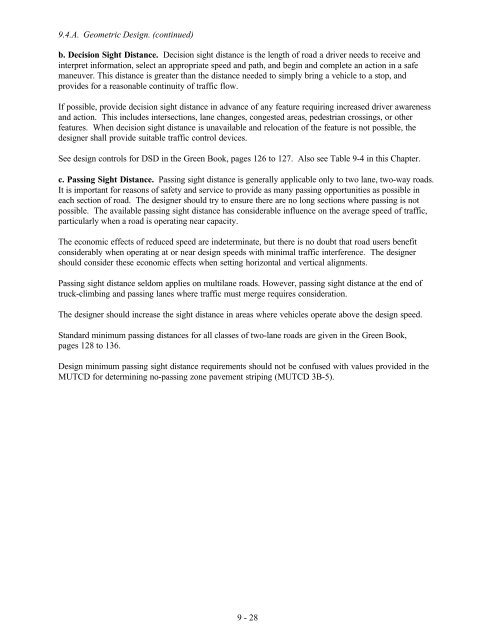FLH PDDM Chapter 9 - Eastern Federal Lands Highway Division
FLH PDDM Chapter 9 - Eastern Federal Lands Highway Division
FLH PDDM Chapter 9 - Eastern Federal Lands Highway Division
You also want an ePaper? Increase the reach of your titles
YUMPU automatically turns print PDFs into web optimized ePapers that Google loves.
9.4.A. Geometric Design. (continued)b. Decision Sight Distance. Decision sight distance is the length of road a driver needs to receive andinterpret information, select an appropriate speed and path, and begin and complete an action in a safemaneuver. This distance is greater than the distance needed to simply bring a vehicle to a stop, andprovides for a reasonable continuity of traffic flow.If possible, provide decision sight distance in advance of any feature requiring increased driver awarenessand action. This includes intersections, lane changes, congested areas, pedestrian crossings, or otherfeatures. When decision sight distance is unavailable and relocation of the feature is not possible, thedesigner shall provide suitable traffic control devices.See design controls for DSD in the Green Book, pages 126 to 127. Also see Table 9-4 in this <strong>Chapter</strong>.c. Passing Sight Distance. Passing sight distance is generally applicable only to two lane, two-way roads.It is important for reasons of safety and service to provide as many passing opportunities as possible ineach section of road. The designer should try to ensure there are no long sections where passing is notpossible. The available passing sight distance has considerable influence on the average speed of traffic,particularly when a road is operating near capacity.The economic effects of reduced speed are indeterminate, but there is no doubt that road users benefitconsiderably when operating at or near design speeds with minimal traffic interference. The designershould consider these economic effects when setting horizontal and vertical alignments.Passing sight distance seldom applies on multilane roads. However, passing sight distance at the end oftruck-climbing and passing lanes where traffic must merge requires consideration.The designer should increase the sight distance in areas where vehicles operate above the design speed.Standard minimum passing distances for all classes of two-lane roads are given in the Green Book,pages 128 to 136.Design minimum passing sight distance requirements should not be confused with values provided in theMUTCD for determining no-passing zone pavement striping (MUTCD 3B-5).9 - 28
















